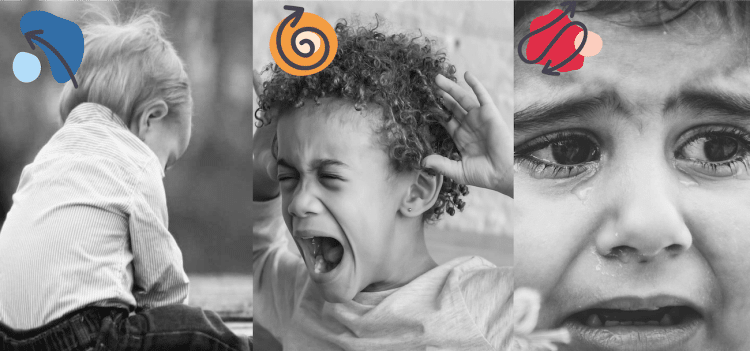Insecure Attachment & Emotional Dysregulation in Relationships

Published on April 18, 2022 Updated on April 25, 2022
Emotional dysregulation is the inability to cope with and react adequately to intense emotions. This capacity is typically developed in childhood, based on the quality of the attachment relationships with our caregivers.
A caregiver that is available and validating to their child’s needs helps their child to recognize, process, and express their emotions in healthy ways [1]. On the contrary, caregivers that did not attend to their child’s emotional needs in the way the child required, or in some way ignored or rejected those needs, are likely to hinder their child’s ability to learn how to deal with different emotional states later in life.
*For more information on this process, check out our article on the development of emotion regulation in children.
Emotion regulation entails a skill set that is necessary for us to function independently, happily, and peacefully. In contrast, emotional dysregulation can harm many areas of our lives – especially our romantic relationships.
That’s why in this blog post, we will focus on how emotional dysregulation may affect our relationships. We will also go into detail about the role of insecure attachment in emotional dysregulation. Furtheermore, we end this article with a few tips on how to help an insecure partner develop better emotion regulation.
Why Is Emotional Dysregulation Affected by Attachment?

Secure attachers are typically more skilled at regulating their emotions than insecure attachers due to the fact that their caregivers were sensitive to their needs growing up [2]. This attuned parental attitude essentially demonstrates to children that emotions are valid and worth talking about. This, in turn, builds healthy communication and emotion regulation skills. Thus, it’s evident that secure attachment and the ability to healthily regulate emotions are strongly linked. Both blossom from a stable early relationship with caregivers.
What’s more, our ability to regulate emotions as children transfers into our teenage and adult years. Our attachment style has been shown to remain relatively stable throughout our lives. Thus, it continues to influence our emotion regulation processes. This means that, in a romantic relationship, an insecure attacher may struggle with emotional dysregulation as they are trapped in a maladaptive cycle of falling back on emotion-focused strategies that they adopted as children, rather than more effective practical solutions [3]. Therefore, they are more likely to feel misunderstood in their adult relationships but struggle to understand why.
Emotion Regulation Strategies of Secure vs. Insecure Attachers
What exactly are the differences between how someone with a secure attachment manages their emotions in comparison to someone with an insecure attachment?
Secure Attachment: Emotion Regulation
For starters, secure attachers are less likely to view an upsetting situation in a threatening way [3]. They are also generally more optimistic and don’t typically exaggerate emotional responses to conflict or distress. They are more confident in handling threats or danger. Additionally, they are efficient at problem-solving [4]. Their upbringing had a strong influence on this optimistic and comfortable attitude towards emotional distress. Since they felt protected and supported to explore the unknown world as children, they can bring this sense of serenity into adulthood.
Insecure Attachment: Emotional Dysregulation
People with insecure attachment have a greater difficulty identifying and understanding emotions. They are also more likely to struggle with mindfulness [4]. Insecure attachers usually did not get the same availability and validation from their parents (that secure attachers did). They learned that others will not validate their emotions or be available to them in the way they need. For this reason, insecure attachers are more likely to experience emotional dysregulation.
Whereas secure attachers felt protection and support from their parents, insecure attachers likely did not. Insecure attachers didn’t have the same opportunities to develop the skills to deal with emotional distress calmly.
Attachment anxiety & emotional dysregulation

Anxious attachers tend to exaggerate their emotional responses through coping mechanisms such as over-thinking, especially in a negative, gloomy tone. They are also hyper-vigilant, which adds to the experience of distress. People with high attachment anxiety will remember more times when they felt sad or anxious as young children. Because they experience their emotions so intensely and frequently, anxious attachers will more likely overthink dooming scenarios, such as going through a breakup [4].
Anxious attachers have an especially hard time finding other focus points when in emotional distress. In fact, they tend to ruminate on what is bothering them. Because of this, they have a harder time implementing a problem-solving approach to emotional stress.
People with higher anxiety in attachment are also likely to express their need for closeness indirectly, due to fear of abandonment [3]. They might also use support-seeking strategies that are maladaptive, such as clinging, smothering, or even trying to control their partners [3].
Attachment avoidance & emotional dysregulation

Avoidant attachers are more likely to apply distancing and disengaging strategies to cope with emotional distress. They are less likely to have access to memories of feeling sad or anxious as small children [4]. Furthermore, they avoid latching on to memories of when they felt negative emotions as kids. This might be because these memories remind them of how their parents weren’t validating or supportive.
Avoidant attachers are great at suppressing any thoughts of break-ups and separation [4]. This works as a defense mechanism against their negative emotions. They also live by the “out of sight out of mind” motto, as they will not dive deeply into issues that are hypothetical.
Moreover, avoidant attachers tend to use distancing strategies, even going as far as “ghosting,” to avoid being rejected themselves. As kids, they learned to avoid rejection from their parents with this same strategy. Thus, distancing can turn into relationship-threatening behaviors, such as cheating in more extreme cases, all in a non-conscious way of avoiding rejection from a loved one [3].
Do Insecure Attachers Always Struggle with Emotional Dysregulation?
Although it can seem like insecure attachers are doomed to struggle with emotional dysregulation, this is not necessarily the case. Although we outlined their typical traits according to research in this article, we are not in any way suggesting that these findings apply to all anxious, avoidant, or disorganized attachers.
People high on attachment avoidance are not always going to resort to distancing and evading strategies. This is just their behavioral pattern to certain conflicts and threats specifically to avoidant attachment triggers, such as a partner asking for proximity [5].
In a similar way, those high on attachment anxiety do not always act clingy or controlling. These patterns of behavior are triggered by threats to the proximity that they require from their partner, such as when the partner is going away for some time, or when there is miscommunication [5].
What Can I Do to Help My Partner’s Emotional Dysregulation?
Secure attachers can help their insecure partners to objectively analyze the raw emotions caused by their attachment triggers and to process them in healthy, effective ways. This is because the secure partner usually helps the insecure one feel safe, seen, and protected [5].
Here are a couple of ways in which a secure partner can help an insecure one regulate their emotions:
Emotional Dysregulation Tip #1: Communicate
Open conversation regarding your feelings is the key to developing healthy patterns of emotion regulation. By discussing emotions freely, we are ultimately showing our partners that their emotions are valid and worth talking about. When opening up these channels of communication, use non-confrontational language, and assure your partner that you are there to listen in a non-judgemental manner.
Emotional Dysregulation Tip #2: Be patient.

Insecure attachers have likely struggled with regulating their emotions from a very young age. Therefore, they may have highly ingrained and ineffectual methods of coping with their negative feelings. Consequently, secure attachers may struggle to understand their insecure partner’s coping methods – they may even find these methods irrational or strange.
If you are securely attached, try not to let your own vision of how things should be processed get in the way of supporting your partner’s difficulties. Empathy goes a long way in helping a partner comprehend how their current methods are ineffective.
Emotional Dysregulation Tip #3: Be proactive.
If you notice that you or your partner are falling into an unhealthy pattern of emotion regulation, it’s best to nip it in the bud and talk about it sooner rather than later. Doing so can help the maladaptive pattern from becoming too ingrained. It might also make it easier to identify the particular trigger that set it off in the first place.
Emotional Dysregulation Tip #4: Be kind.
Don’t just practice kindness in your attitude towards others – make it a part of how you speak to yourself. If you are the one going through an emotionally difficult time, remember that these difficulties happen to us all at some stage of our lives. Also, if it’s a partner or loved one that is struggling, bear in mind that it could be due to a lack of sufficient care, love, and attention in their formative years. It’s never too late to help someone feel secure and safe – so now is a great time to start!
References

- Roque, L., Veríssimo, M., Fernandes, M., Rebelo, A. (2013). Emotion regulation and attachment: Relationships with children’s secure base, during different situational and social contexts in naturalistic settings. Infant Behavior and Development, 36(3), 298-306.
- Waters, S.F., Virmani, E.A., Thompson, R.A., Meyer, S., Raikes, H.A., Jochem, R. (2009). Emotion Regulation and Attachment: Unpacking Two Constructs and Their Association. Journal of Psychopathology and Behavioral Assessment, 32, 37-47.
- Pascuzzo, K., Cyr, C., Moss, E. (2012). Longitudinal association between adolescent attachment, adult romantic attachment, and emotion regulation strategies. Attachment & Human Development, 15(1), 83-103.
- Mikulincer, M., Shaver, P.R. (2019). Attachment orientations and emotion regulation. Current Opinion in Psychology, 25, 6-10.
- Simpson, J.A., Rholes, W.S. (2017). Adult attachment, stress, and romantic relationships. Current Opinion in Psychology, 13, 19-24.











 Get mental health tips straight to your inbox
Get mental health tips straight to your inbox








